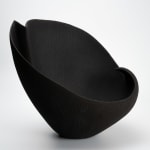Matsutani Fumio 松谷文生 b. 1975
H25.4 × W28.6 × D25.1 cm
Further images
-
(View a larger image of thumbnail 1
)

-
(View a larger image of thumbnail 2
)

-
(View a larger image of thumbnail 3
)

-
(View a larger image of thumbnail 4
)

-
(View a larger image of thumbnail 5
)

-
(View a larger image of thumbnail 6
)

-
(View a larger image of thumbnail 7
)

-
(View a larger image of thumbnail 8
)

-
(View a larger image of thumbnail 9
)

-
(View a larger image of thumbnail 10
)

-
(View a larger image of thumbnail 11
)

-
(View a larger image of thumbnail 12
)

Born in 1975, Matsutani Fumio creates soaring ceramic sculptural vessels in his studio in Ehime Prefecture on Shikoku Island. His mostly hand-built process begins with shaping clay by hand, allowing it to dry, and then refining the form through detailed incisions. He etches single lines across the entire piece, glazes and fires it multiple times, and finally finishes it with sandpaper. Because he lives in Shikoku, where the weather is both dry and slightly humid and extremely cold in the winter, he lets the clay dry naturally overtime instead of firing, as firing his layered glazes would crack the clay. Therefore, his works take months at a time to complete, with particularly lengthy drying times during the winter seasons. A rising star in the ceramic landscape, Matsutani has won many awards in a competitive Japanese ceramic society.
Born into a family known for Tobe ware (砥部焼, Tobe-yaki), Matsutani grew up in his family studio surrounded by hand-thrown, mass-produced porcelain utensils decorated in dark cobalt blue. Departing from his family tradition, he sought to broaden his creative horizons and explore contemporary expressions of ceramics.
At the age of twenty, Matsutani enrolled at Kyoto Saga University of Arts, where he studied under Imai Masayuki (1930–2023), who specialized in colorful inlaid ceramic works. It was here that Matsutani's interest in color began. Colors play a critical role in his ceramic language, and many of his recent pieces are titled with a single Japanese Kanji character: Sō 蒼 (Blue), Ō 黄 (Yellow), or Rei 黎 (Black). About this, he has stated:
“I use colors as titles, without adding any descriptive words, because all that really matters is the feeling of the works and I want them to speak for themselves. To put it another way, ‘The technique is complex, but the expression is simple.’”
His disciplined technical foundation is built on both workshop experience and art-college training. As a result, Matsutani has developed a practice that also embraces challenging forms inspired by forms outside of the ceramic medium:
“Mankind has always created buildings that seem to defy gravity. Although ceramics and architecture aren’t the same, I feel the same way about my sculptures … In future I’d like to create works formed by arranging and stacking multiple components, defying gravity but at the same time working with it.”











